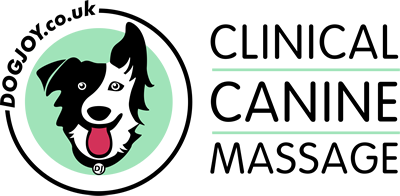If you have noticed, or have concerns about, your dog’s mobility and /or behaviour, you can easily classify your observations with the 5 Principles of Pain, a useful aid for identifying symptoms of musculoskeletal conditions that could be helped by clinical canine massage.
The signs of muscular pain listed can be mistaken by some owners as simply signs of ageing or ‘just something they do’. The reality is, however, that muscular pain can be caused by anything from normal activities of daily living to chronic, arthritic conditions.
If you need more information or have anything you’d like to discuss about your dog, feel free to contact me for an informal chat. I am also available to provide muscular health checks, and presentations on Clinical Canine Massage at events.
Read about the Benefits of Clinical Canine Massage here
Learn more by downloading our Five Principles of Pain Document
The Five Principles of Pain
- Lame / limping /carrying a leg or paw
- Reduced range of movement
- Stiff when moving
- Slowing down on walks
- Abduction or adduction
(throwing a leg) - Single tracking
- Pacing
- Hopping/skipping
- Lack of reach or drive
- Crabbing
- Coat changes / flicking up / dry in area
- Kyphosis (roaching) /Lordosis (swayback)
- Twitching, or ‘shivery’ skin
- Inexplicable tremors
- Tail carriage e.g., swimmers tail
- Neck / back / shoulder issues
- Uneven nail wear
- Hip or stifle rotation(dog stands / sits with knee pointing out)
- Down on the wrist
- Struggling to get up on or down from sofa, stairs, car
- Not settling, pacing at night time
- Weakness in back legs
- General signs of ageing
- Struggling / slowing down on walks
- Difficulty rising from lying down
- Slipping / unbalanced on flooring
- Lying down to eat
- Reluctance to be petted /groomed / examined
- Disinterested in life /isolating themselves /depressed
- Self mutilation e.g., nibbling their hind area
- Lick granuloma, e.g., excessive licking of wrist
- Snapping when touched or towel dried
- Snapping at other dogs as a pre-warning for them to stay away
- Anxiety
- Frequent rolling on back
- Agility dogs – pole knocking, weave and /or contact issues, lack of drive, measuring,
- Gun dogs – early onset fatigue, retrieval issues
- Canicross – early onset fatigue, reluctance to wear harness, not pulling
- Obedience – change in work positions e.g., down stay / sendaway
- Flyball -Turning wide on box, missing/avoiding jumps
- All disciplines: any deviation from natural performance
If you have noticed, or have concerns about, your dog’s mobility and /or behaviour, you can easily classify your observations with the 5 Principles of Pain, a useful aid for identifying symptoms of musculoskeletal conditions that could be helped by clinical canine massage.
The signs of muscular pain listed can be mistaken by some owners as simply signs of ageing or ‘just something they do’. The reality is, however, that muscular pain can be caused by anything from normal activities of daily living to chronic, arthritic conditions.
Read about the Benefits of Clinical Canine Massage here
If you need more information or have anything you’d like to discuss about your dog, feel free to contact me for an informal chat. I am also available to provide muscular health checks, and presentations on Clinical Canine Massage at events.
Learn more by downloading our Five Principles of Pain Document
The Five Principles of Pain
- Lame / limping /carrying a leg or paw
- Reduced range of movement
- Stiff when moving
- Slowing down on walks
- Abduction or adduction
(throwing a leg) - Single tracking
- Pacing
- Hopping/skipping
- Lack of reach or drive
- Crabbing
- Coat changes / flicking up / dry in area
- Kyphosis (roaching) /Lordosis (swayback)
- Twitching, or ‘shivery’ skin
- Inexplicable tremors
- Tail carriage e.g., swimmers tail
- Neck / back / shoulder issues
- Uneven nail wear
- Hip or stifle rotation(dog stands / sits with knee pointing out)
- Down on the wrist
- Struggling to get up on or down from sofa, stairs, car
- Not settling, pacing at night time
- Weakness in back legs
- General signs of ageing
- Struggling / slowing down on walks
- Difficulty rising from lying down
- Slipping / unbalanced on flooring
- Lying down to eat
- Reluctance to be petted /groomed / examined
- Disinterested in life /isolating themselves /depressed
- Self mutilation e.g., nibbling their hind area
- Lick granuloma, e.g., excessive licking of wrist
- Snapping when touched or towel dried
- Snapping at other dogs as a pre-warning for them to stay away
- Anxiety
- Frequent rolling on back
- Agility dogs – pole knocking, weave and /or contact issues, lack of drive, measuring,
- Gun dogs – early onset fatigue, retrieval issues
- Canicross – early onset fatigue, reluctance to wear harness, not pulling
- Obedience – change in work positions e.g., down stay / sendaway
- Flyball -Turning wide on box, missing/avoiding jumps
- All disciplines: any deviation from natural performance

